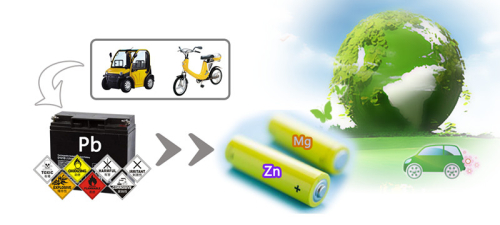
The rapid development of low-speed electric vehicles and new energy grids has increased the demand for new low-cost batteries. At present, lead-acid batteries occupy the vast majority of low-speed electric vehicle power supplies and fuel car start-up power supplies with their mature technologies and low prices. market share. However, used lead-acid batteries have brought huge environmental risks to the environment. China has clearly formulated a policy of gradually replacing lead-acid batteries. However, due to the higher cost of commercial lithium-ion batteries, their development in the field of low-cost batteries is limited. Therefore, establishing a low-cost, high-efficiency battery system is the key to accelerating the lead-free pace. Power batteries are in the golden stage of development. The layout of new low-cost, high-performance battery systems is ahead of schedule. The commanding heights of basic research and industrialization technologies are the key to China’s leading position in energy competition in the coming decades. Based on the progress made in the early stage of high-energy-density solid-state lithium batteries, relying on the Qingdao Institute of Energy Storage Technology, established by the Qingdao Institute of Bioenergy and Bioprocess Technology, Chinese Academy of Sciences, the innovative design and process optimization of new battery key materials are the starting point. Over the years, it has conducted in-depth systematic application basic research and has made some progress recently.
Under the guidance of Chen Liquan, an academician of the Chinese Academy of Engineering, Qingdao Energy Storage Institute discovered for the first time that an ultra-high concentration of organic metal salt-based electrolyte can effectively improve the disadvantages of low charging efficiency and poor cycle life of zinc batteries, thereby developing long cycle life and high energy. Density New Type Zinc Secondary Battery (Electrochem. Commun., 2016, 69, 6). At the same time, the effective charging of zinc battery devices has been dramatically shortened through the design of new multivalent framework electrode structures (ACS Appl. Mater. Interface, 2015, 7, 26396). The electrode-electrolyte interface compatibility of the two phases has always been a difficult point in the application and basic research of zinc secondary batteries. For the first time, Qingdao Energy Storage Institute has used thermal reversible coagulating polymers to break through the bottleneck of the technology, and innovatively proposed " The concept of low-temperature self-healing solves the problem of battery interface failure (Angew. Chem. Int. Ed. 2017, 56, 7871).
Based on the previous application basic research and technology development, Qingdao Energy Storage Institute has broken through the technical bottlenecks in zinc battery integration and pilot plant equipment and successfully developed a new type of zinc secondary battery with large capacity and low cost. The device has an energy density > 40 Wh/. Kg, cycle life> 500 times, cost < 0.7 yuan/Wh, and pass the harsh tests such as nail penetration and extrusion required by the national standard. The experimental data show that the new type of zinc battery with excellent performance is expected to be applied in special fields of low-speed electric vehicle power supply, scale energy storage and flexible energy storage devices.
Magnesium secondary batteries are another important solution for lead-free low-cost batteries. Qingdao has rich magnesium resources and has unique advantages in the development of magnesium batteries. However, the current bottleneck problem of magnesium secondary batteries is the lack of stable, non-corrosive, wide potential window electrolyte systems. Qingdao Energy Storage Institute has innovatively proposed the design concept of boron-based anion-based magnesium-based electrolytes, and synthesized magnesium-based electrolyte systems with high ionic conductivity, non-nucleophilic properties, and wide electrochemical windows. A high energy density magnesium battery system was constructed (Adv. Energy Mater., 2017, 1602055; Small 2017, 1702277; Electrochem. Commun., 2017, 83, 72; J. Mater. Chem. A, 2016, 4, 2277). In terms of electrochemical mechanism, the change in the formation energy of magnesium-based electrode materials and the evolution of crystal structure were revealed, laying the foundation for a deep understanding of the specific reaction paths and mechanisms of the rapid kinetic transformation of magnesium secondary batteries (Adv. Funct. Mater., 2017, 10.1002/adfm.201701718). The new magnesium secondary battery design concept provides new ideas and directions for the future development of low-cost batteries.
Prospective technological research on new zinc and magnesium secondary batteries is bound to accelerate the process of green lead-free development in low-speed electric vehicles and low-cost battery-related fields, and make important technical contributions to the industrial green development of Shandong and even China.
The above research projects have received strong support from the National Outstanding Youth Fund, the Qingdao Energy Storage Fund, and the “1-3†project of the Qingdao Energy Institute.
Our Handmade Mats is functional , unlike plastic , they don`t wear out easily . Each handmade mat is rich in color , with a neutral color , natural and simple , elegant atmosphere , can bring fresh feeling for home . And they are the perfect item to decorate your table for any occasion : holiday entertaining , parties , gatherings , birthdays , special occasions , everyday meals and more .
Our handmade mats are available in various colors, designs, shapes and styles. We offer these mats in various packaging options and are delivered within the scheduled time - frame. The offered products can be customized as per the client''s requirements.
Handmade Mats
Handmade Mats,Hand Cushion,Handmade Bath Mat,Handmade Floor Mats
Shandong Guyi Crafts Co.,Ltd , https://www.guyicrafts.com